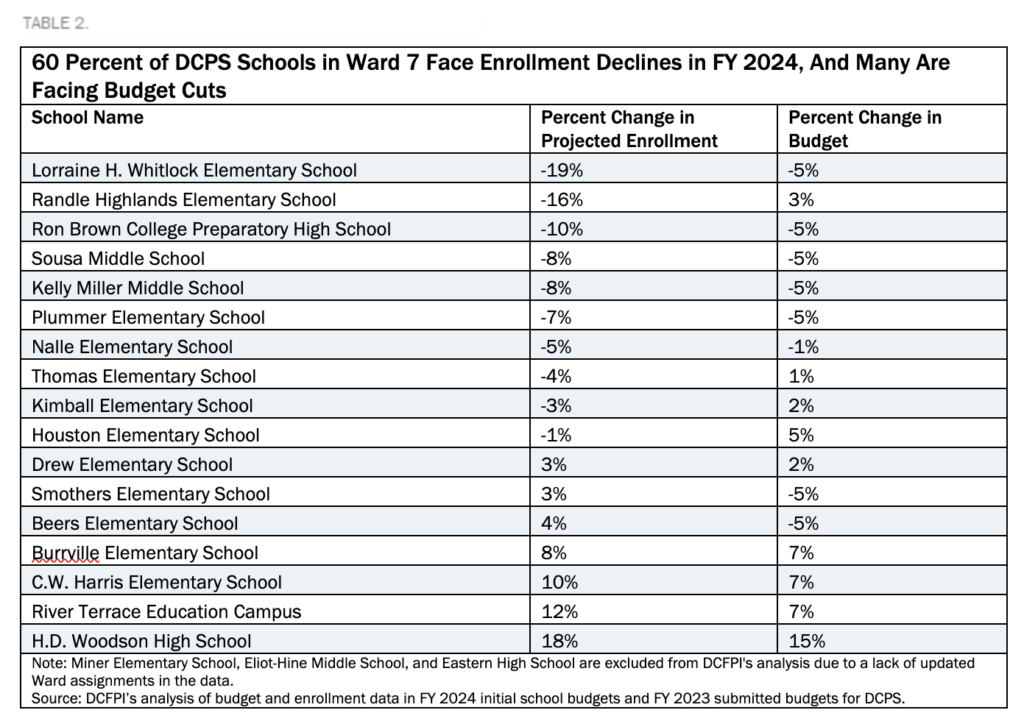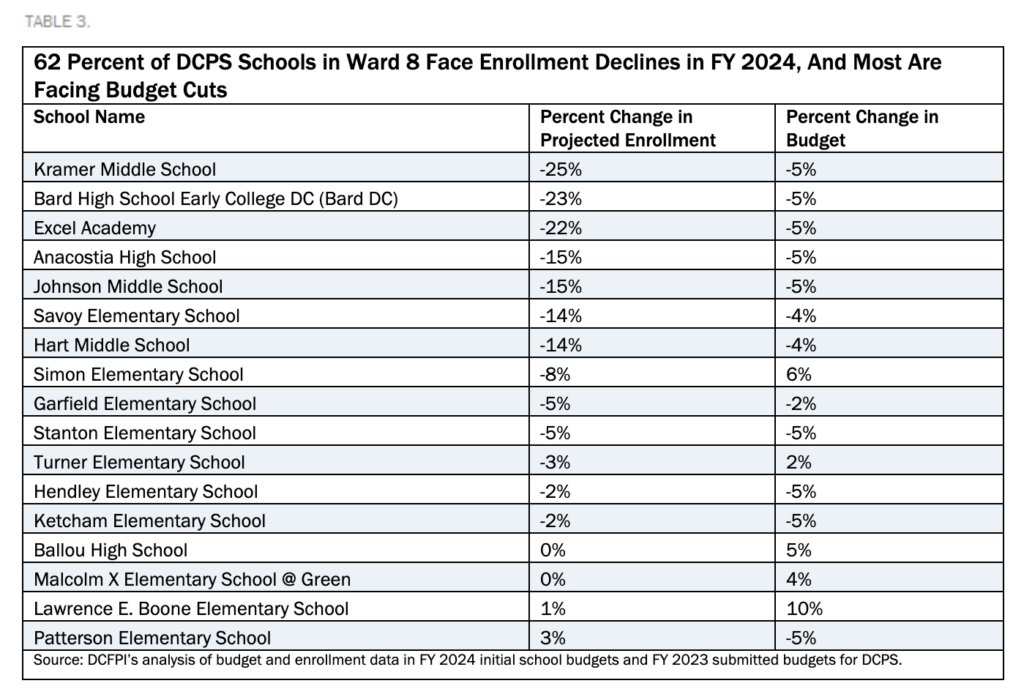Chairperson Mendelson, members of the Committee, and Committee staff, thank you for the opportunity to testify. My name is Qubilah Huddleston, and I am a Senior Policy Analyst at the DC Fiscal Policy Institute (DCFPI). DCFPI is a non-profit organization that shapes racially-just tax, budget, and policy decisions by centering Black and brown communities in our research and analysis, community partnerships, and advocacy efforts to advance an antiracist, equitable future.
Today, I would like to discuss DCFPI’s preliminary analysis of the fiscal year (FY) 2024 initial school budgets for DC Public Schools (DCPS). Given reoccurring troublesome trends in budgets and enrollment in schools in in Wards 5, 7, and 8—which serve a majority of Black and brown students and students from families with low incomes—our analysis focuses on these wards. Key observations within our analysis include the following:
- Forty-nine percent of schools’ initial budgets are larger than their FY 2023 submitted budgets, while 51 percent of schools have budgets that are smaller.
- All schools with budget reductions are receiving at least 95 percent of their prior year budget inclusive of all recurring, one-time, local, and non-local funding sources.
- Yet again, DCPS is projecting significant enrollment losses in schools in Wards 7 and 8, necessitating the Mayor, DC Council, and education officials to meaningfully articulate and demonstrate an equitable vision for and commitment to neighborhood schools.
- One-time stability funding through the Mayor’s Recovery Fund makes up between five and nine percent of some schools’ budgets, necessitating an explicit and actionable plan to prevent these and other schools from experiencing a sharp fiscal cliff in future fiscal years.
Half of the Schools Have Growing Budgets, the Other Half Have Shrinking Budgets
For DCPS schools in Wards 5, 7, and 8, there is a roughly fifty-fifty chance of facing a cut under the Mayor’s proposed FY 2024 initial school budgets compared to the FY 2023 submitted budgets, using nominal data. Twenty-five schools in these wards are facing funding increases, whereas 26 schools are facing decreases (See Appendix). Of the 26 schools losing funding, 20 are projected to lose students. Among school budgets that are increasing, DCPS projects enrollment losses for nine of those schools.
Given the relationship between enrollment and school funding in the DCPS student-based budgeting model, one would expect to see a more direct association between enrollment and funding changes. Observing enrollment increases for schools that are projected to lose students is confusing and reflects potential inconsistencies in how DCPS applies its school funding model. Yet, further analysis of projected enrollments for specific student groups, such as students receiving special education (SPED) services, English Learners (EL), and students designated “at-risk” of academic failure suggests that some of the inconsistencies are, in part, attributable to changes in the composition of schools’ populations. DCPS funds students in these categories at a higher pupil amount. Therefore, while a school may be projected to lose students on net, the school could be gaining SPED, EL, or at-risk students that would result in a budget increase. Similarly, a school could be gaining students on net, but be projected to lose SPED, EL, or at-risk students, causing the school to lose more money given those students carry a higher per-pupil funding amount.
DCFPI encourages DCPS to improve transparency and better explain why some schools’ budgets are increasing or decreasing. The current format of publicly available budget documents makes it difficult for the public to discern why and how a school’s budget could be decreasing even if enrollment is growing or remains unchanged.
DCPS Needs a Plan for School Budgets Receiving One-Time Recovery Funds
Schools in Wards 7 and 8 are the most likely to face a fiscal cliff in FY 2025 due to the loss of recovery funds absent proactive planning from policymakers. Our analysis shows that 10 schools, or about one in five, across Wards 5,7, and 8 have budgets in which stability funding makes up five or more percent of the school’s budget. Stabilization and safety net supplement funding, two categories of stability funding in FY 2024 initial budgets, are recurring sources that DCPS provides to schools. However, stability funding from the Mayor’s Recovery Fund is one-time funding, and FY 2024 is the final year of the fund. Twelve schools receive Mayor’s Recovery Funds, with 11 of those being in Wards 7 and 8. Eight of those 12 schools have initial budgets in which this funding makes up at least five percent of their budget, a sizeable loss that would carry consequences for children already the furthest from opportunity. Sousa Middle School in Ward 7 has the largest percentage of its budget made up of one-time stability funding at nine percent (Table 1).
DCPS should be proactively planning for how it will protect these and other schools relying on one-time stability funding from experiencing a sharp fiscal cliff moving forward. Figuring this out next budget season will be too late.
DCPS Is Trying to Stabilize School Budgets Despite Significant Declines in Projected Enrollment
Two things can be true at the same time: students deserve more and targeted resources to reach their full potential and steep enrollment declines in certain communities undermine the DCPS’s ability to provide more and targeted resources to students. In FY 2020, DCPS issued initial school budgets in which 85 percent of the school budgets that were decreasing by more than five percent were concentrated in Wards 7 and 8.i Many of those schools were projected to experience sharp declines in enrollment. For FY 2024, many of those same schools are yet again projected to lose students, but DCPS is ensuring that schools receive at least 95 percent of their prior year’s budget, inclusive of local, non-local, recurring, and one-time fund sources (Tables 2 and 3).
The enrollment projections in the figures above are alarming and deserve thoughtful budget and policy responses. In Ward 8, several schools are projected to lose 15 percent of their student population next school year, with a few schools projected to lose 20 percent or more. These schools are serving high percentages of students who are designated at-risk, and they tend to have higher SPED populations than schools in whiter, wealthier parts of the District. These are schools that need more, not less resources yet ongoing enrollment loss continues to threaten that possibility.
DCFPI has previously testified on how DCPS could explore adding a new weight to its funding model for schools with below average enrollments, whose funding is more sensitive to enrollment fluctuations. Addition of such a weight could especially help small schools by reducing their need to rely on their “at-risk” and other targeted support funding to cover basic educational costs. Even still, more action is needed to address the disturbing enrollment trends in Ward 7 and 8 schools.
To Truly Stabilize School Budgets, Policymakers Must Stabilize Enrollment at Neighborhood Schools
DCFPI has testified before on how enrollment declines in neighborhood schools continue to hit schools in the District’s Blackest and lowest income communities the hardest. We observe similar trends in the projected enrollments for FY 2024. DCPS projects that 29 schools, or 57 percent, will lose enrollment across Wards 5, 7, and 8—with schools in Wards 7 and 8 making up many of the schools that are projected to lose students. Next week, my colleague Michael Johnson will testify about longer term enrollment trends and implications for these communities that will underscore the points I am testifying about today.
Whether it is DCPS’s one-year old budget model or the newly adopted Schools First in Budgeting (Schools First) funding allocation model, continued enrollment loss will undermine true school budget stability at our District’s neighborhood schools. DCPS’s budget model is a student-based budgeting model that is primarily driven by enrollment. The Schools First allocation model deviates from the agency’s model in that it sets a floor of local recurring funding—based on prior year funding—upon which DCPS is instructed to incrementally increase funding according to certain provisions. However, the Schools First allocation model also allows for DCPS to incrementally decrease a school’s budget according to certain provisions pertaining to projected enrollment declines.
It is unclear to DCFPI how either model will go far enough to provide budget predictability or stability to students, families, and educators at schools that continue to lose too many students. Policymakers need to comprehensively invest in families and communities, such as centering anti-displacement strategies in housing policy and addressing safety concerns, so that they can feel like their neighborhood schools are viable options. Neighborhood schools are important community institutions and should be well-resourced and supported as part of DC’s robust school choice portfolio.
Policymakers should be alarmed by enrollment trends at schools serving students with the highest barriers to learning inside and outside of the classroom. More importantly, policymakers should act. Next school year, DCPS projects that two schools in Ward 8 will lose more than 100 students. There are other schools in Wards 7 and 8 that are projected to lose 40 or more students. How are schools to improve if they keep losing so many students and consequently, funding? Will the Council indiscriminately reduce DCPS’s central office each year to address budget reductions because of enrollment losses? Sustained enrollment losses and indiscriminate budget cuts to central office are not sustainable strategies for stabilizing school budgets or the agency. DCFPI is deeply concerned that policymaker’s failure to holistically examine school budget instability will result in harmful, intractable consequences for neighborhood schools serving majority Black students and high percentages of students designated “at-risk” of academic failure.
To truly address school budget stability, DCFPI urges the Mayor, DC Council, and education officials to articulate and demonstrate an equitable vision for and commitment to neighborhood schools. DC children and families should not have to wait any longer for District leaders to act. Failure to remedy concentrated enrollment declines at neighborhood schools in Wards 7 and 8 amid a backdrop of 253 and growing schools is irresponsible and undermines DC’s promise of a high-quality public education to all students.
Thank you for the opportunity to testify. I am happy to answer questions.



